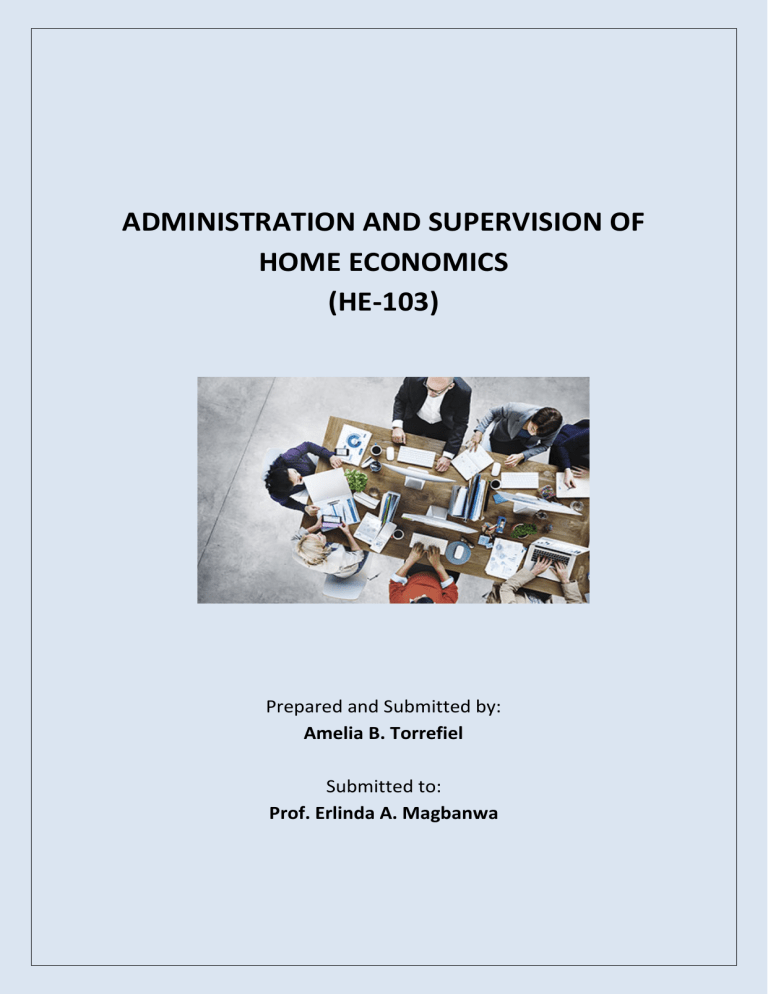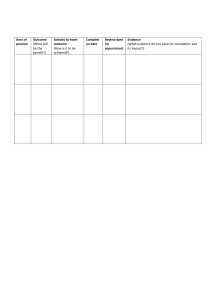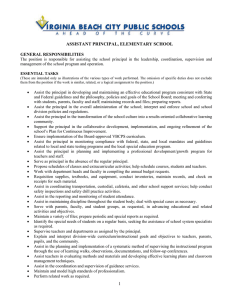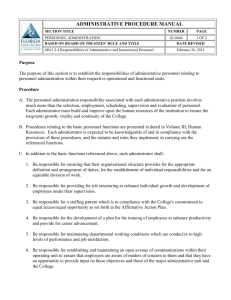
ADMINISTRATION AND SUPERVISION OF HOME ECONOMICS (HE-103) Prepared and Submitted by: Amelia B. Torrefiel Submitted to: Prof. Erlinda A. Magbanwa Module 1 Activity Educational Administration Lesson III – Foundations of Educational Administration 1. What is administration and supervision? 2. What are some major functions of administration and supervision? 3. How is administration and supervision become interesting? Analysis 1. What are the types of administration? 2. What is the meaning of school administration? Explain with examples 3. What are the different types of leadership style in education? Abstraction 1. Make your own abstract of what you have learned in Module I Application 1. How can you apply/practice administration and supervision in your class? ACTIVITY I. What is administration and supervision? It is a learning process involving face to face regularly scheduled conference with a qualified social work administrator which are designed to promote development of professional responsibility skill, knowledge and ethical conduct in the administration of social work/ human services. Educational administrative and supervision programs focus on the general programs, principles and method to teach students how to manage school and other educational organization. Specific programs included higher education / higher education administration / Secondary School Administration / principalship. II. What are some major functions of administration and supervision? 1.) Planning - is an essential component. It is useful to be undertaken by the administrators. It involves systematic organized and articulated scheme of working. So planning can be taught of at the beginning of the session. 2.) Organization - is also an important function of good administration. The effective and the efficient of the work of the school depends upon the good organizations. The essential element of the people: What they do and how they work together. - So having a good organization the administration should clearly defined its purpose, analyze and identify task required to meet the objective., allocate related activities to other staff provide for management and coordination of activities of each level of responsibilities and to establish reporting and communication channel system. 3.) Direction - has also an important function of educational administration. Its direction involves getting the work done through instructional orders. There should be proper supervision, motivation and communication on the part of administrator for getting work done. The ultimate aim is to see that work is accomplished according to policies and programs and given instructions. Directing involves exercising leadership motivating people, determining accountability and developing guidelines for action. 4.) Controlling - involves measuring and monitoring performances, comparing results with plans and taking corrective actions when required, it indicates how far the goals have been achieved and to what extent there is deviation from the plans. The basis of control is measurement control deals with the difference between planned and actual performances. - In the administration concerned with managing resources, allocating task, making decisions and solving problems. The function is to create favorable conditioning for educational process and their maintenance at an effective level. For effective organization, good administration should involve planning, organization, networking and direction. III. How is administration and supervision become interesting? It might of confusing, which some school personnel missed to provide its nature. It might be interesting because these two other says synonymous to each other but it plays different roles in any organization specifically in education .Both terms cannot be separated from each other since they are into the coordination and with mutually shared functions in the operation of its system. Take note that educational administration provides and manages elements along teaching-learning situation such as putting together pieces and resources in the most advantageous ways for teachers and students though no direct contacts made (supporting system) while educational supervision narrows on the continuous adequacy to bring necessary advancements or improvements to teachers (ensuring the educational services provided by teachers to students based from program or tracks are in the best standard or quality standards. A good interpersonal relationship between these are vital since its play an integral part in the gestalt operation of the organization. ANALYSIS I. What are the types of administration? • Preschools Administration Preschools are often small enough therefore a single supervisor with some of the faculty members can manage them. The administration of the school depends only on the director, ensuring that the curriculum, finances and projects are done correctly and ensure that the school follows educational standards. • Elementary and Secondary School Administration The principal also plays a major part in supervising projects and other development to better serve the students. Elementary school administrations, through the Parent-Teacher Association, also meet with parents to make sure that their children are getting the best education and services that the school can offer. A principal heads up most school administrations in this category. • College and University Administrations College and University Administrations are largely different from elementary and secondary school administrations; they are larger and have more specific functions since they manage a very large school community. The first major difference is that college and university administrations are headed by a president and a governing that handles all aspects related to school management, like finances and projects. II. What is the meaning of school administration? Explain with examples • The school administrator identifies and articulates a school's mission and goals and makes them happen by implementing programs, delegating tasks and allocating resources. One of a school administrator’s main jobs is to set a school’s budget. It is his job to account for local and federal funding. He also decides how to spend the funding. Do the computer classes need new system units, or should the money be spent on new bleachers for the basketball field? It is often the school administrator’s job to decide or to delegate the decision to someone else. III. What are the different types of leadership style in education? • Instructional leadership – involves the practice of planning, evaluation, coordination and improvement of teaching and learning. Working directly with the teachers’ instructional leaders evaluate teacher performance and help advance their skills through mentoring and coaching. Becoming an instructional leader entails time spent solving pedagogical problems, taking an action to • Transformational leadership - Transformational leaders are able to influence school outcomes by outlining highperformance expectations, developing people through individual support, building productive relationships and providing instructional support. • Constructivist leadership - facilitating the learning process, rather than directing it. At the core of the constructivist approach is that learners control their own learning, not teachers. Acknowledging that every learner understands, processes and gives meaning to lessons through their own reality, constructivism places a priority on customized teaching approaches that take into consideration individual learning needs. • Servant leadership - pushes the ego aside and considers the needs of others, rather than focus on self-interest. The philosophy behind servant leadership is that a “great leader must first serve others and that this simple fact is central to his or her greatness: true leadership emerges from those whose primary motivation is a desire to help others.” School leaders who practice servant leadership maintain high expectations; however, they also help teachers and students to develop their skills to improve their performance. These leaders instill the desire for improvement while maintaining a focus on both results and relationships. • Strategic leadership – is based on long-range planning. Through analysis, evaluation and monitoring, strategic leaders assess current school performance and take the necessary steps to improve future results. These leaders not only set the direction of the school by having an organizational vision, they create frameworks, set up interventions, allocate resources and maintain systems for reforms to take place. ABSTRACTION As a school administrator, you’d have the opportunity to take on more of a leadership role, impacting organizational decisions related to hiring, budget allocation, policy and more. It also cover the typical duties a school administrator may encounter and the educational requirements you’ll need to get there. Without the educational administration, the educational sector would not be able to function effectively or efficiently. The people that fill these roles determine how education is delivered and what it needs to develop and progress into the future. Educational Administrators functions also support teaching staff to deliver this strategy to students and keep educational facilities operating. Last but certainly not least, the educational administrators provide students with a safe and secure space in which they can learn should not be ignored. Having students who are healthy and capable of learning both emotionally and physically is crucial to the success of the education sector. APPLICATION Effective supervision in classroom is evidenced by performing good administrative procedure characterized by disciplined behavior by demonstrating through positive implementation of school rules and regulations directed towards the achievement of the aims and objectives of the class in particular and education in general.


